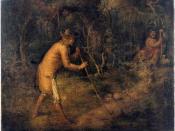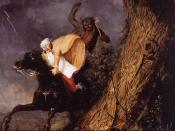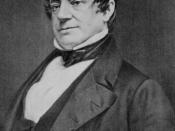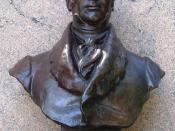Common people in all parts of the world hand down folk tales about their particular culture, and during the nineteenth century in Europe, the popularity of these tales increases. Because Washington Irving lives and travels in Europe during this time period, he reads many of these tales, and his interest in rewriting them grows. One of his tales, "The Devil and Tom Walker," meets the criteria of a folk tale by portraying unrealistic events, featuring stereotyped characters, and teaching moral lessons.
In "The Devil ad Tom Walker," Irving writes of occurrences unlikely to happen in the real word. For example, Tom meets and speaks with the devil. A large man "begrimed with soot" appears before him and admits to being "Old Scratch," a common name in New England for the devil. Irving presents the devil in a physical form and allows him to speak to Tom, something quite unheard of in everyday life.
When Tom's wife disappears in the swamp after an encounter with the devil, Irving presents another unbelievable event. Upon her disappearance, Tom searches for her and the valuables she took, and he finds "nothing but a heart and a liver" in an apron suspended from the tree.
The idea of the devil dismembering a human and leaving her remains proves improbable and doubtful. Irving uses outrageous incidents to elicit interest in his story.
Throughout his writing, Irving uses characters that represent a single trait such as, the devil and Tom Walker. He portrays the devil as cloaked in soot as if he were in a fire.
The black headed man, " neither Negro nor Indian," glared at Tom with "a pair of great red eyes." Irving presents the devil as swarthy and dingy, as he presents him to the reader. Tom was the kind of man who loved his life and would live poorly to keep his money. Due to this guilt with the devil, "Tom consoled himself for the loss of his property." Due to his foolishness and greed, Tom lost everything. This account clarifies the devil and Tom Walker as a few out of many stereotypical characters from this writing.
In this folk tale, Irving presents several lessons and morals. Most of them taught for the best purposes. Tom learns a lesson from the devil as he teaches Tom not to be greedy and honor what you have. To make sure Tom gets the money he asks the how he can prove what the devil told him was true the devil replied, "There is my signature⦠leaving his thumb print against Tom's forehead." This shows that Tom will even make a deal with devil to get what he wants in life. Another moral taught in the story, don't take shortcuts. Tom tries to take to take a shortcut to get rich but his shortcut came with a risk, the devil came to Tom and said, "Tom your come for." Due to Tom making a deal with devil caused him not to live a full and prosperous life. In life it is easier to earn your possessions and don't be greedy take your share of things.
In conclusion, the folk tale "The Devil and Tom Walker" written by Washington Irving gives information on events that could not happen, banal people, and things that can be taught from different people. This writing represents a time period when lessons where being taught and to do so they were put in stories such as this.





